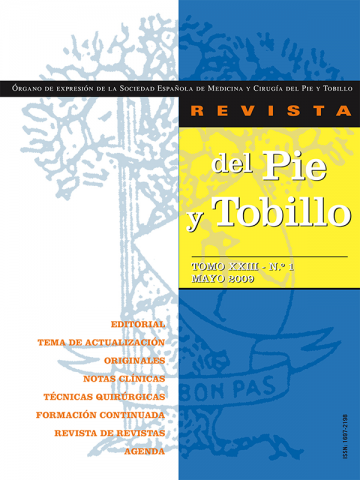Resumen:
Objetivo: evaluar el resultado de la osteosíntesis percutánea mediante tornillos canulados de 7,3 mm en pacientes con fractur de la metáfisis tibial distal extraarticular, tratados en el Hospital 12 de Octubre entre los años 1999 y 2007.
Material y método: estudio retrospectivo de 15 pacientes, 10 varones y 5 mujeres, con una edad media de 49,2 años. Cinco pacientes sufrieron f 43 A1; 6 pacientes, fractura 43 A2, y 4 pacientes, fractura 43 A3. Hubo 7 casos con fractura de peroné asociada y 3 con fracturas abiertas. Ocho de los casos fueron intervenidos el mismo día de su ingreso, mientras que en los 7 restantes la cirugía se demoró una media de 4 días (2-7 días). El seguimiento mínimo de los pacientes fue de 12 meses (media: 58 meses; rango: 12- 108 meses). El tiempo medio hasta la consolidación fue de 14,7 semanas (rango: 8-24).
Resultado: valoración clínico-funcional según la escala de AOFAS para tobillo y retropié. Resultados excelentes en 9 pacientes (60%), buenos en 4 pacientes (27%), regulares en 2 pacientes (13%). Ausencia de casos con deformidad angular o rotacional mayor de 5 grados, y de acortamientos mayores de 1 cm. No se registraron complicaciones infecciosas profundas ni en partes blandas.
Conclusión la utilización de tornillos canulados es una alternativa terapéutica muy válida, para el tratamiento de este tipo de fracturas, pues minimiza el daño de las partes blandas y tiene un bajo coste.
Abstract:
Aims and objetives: to assess the results of percutaneous osteosynthesis using 7.3-mm cannulated screws in patients with extra-articular distal tibial metaphysis fractures treated at the “12 de Octubre” University Hospital (Madrid, Spain) between 1999 and 2007.
Material and methods: retrospective study of 15 patients (10 males, 5 females) with a mean age of 49.2 years. Five patients had an 43 A1 fracture, six had a 43 A2 one and four had a 43 A3 one. Associated fibular fracture was present in seven cases, and there were three cases with open fractures. Eight cases underwent surgery on the same day of their admission, while in the remaining seven cases surgery was postponed by a mean of 4 (2-7) d The minimum follow-up of the patients was 12 months (mean, 5 months; range, 12-108 months). The mean time to consolidation was 14.7 weeks (range, 8-24 weeks).
Results: clinico-functional assessment using the AOFAS scoring scale for ankle and hindfoot. Excellent results in nine (60%) patients, good results in four (27%), and average in two (13%). There were no cases with angular or rotational deformity greater than 5o, nos of shortenings greater than 1 cm. There were no deep nor soft tissue infectious complications.
Conclusions: the use of cannulated screws is a highly valid therapeutic alternative for the surgical management of this type of fractures; it minimizes soft tissue damage and has a low cost.
Keywords:
Extra-articular distal tibia
Fracture
Adults
Orthopaedic therapy
Surgical therapy
Osteosynthesis screws





